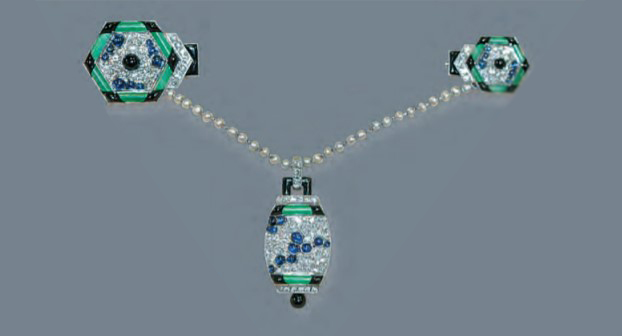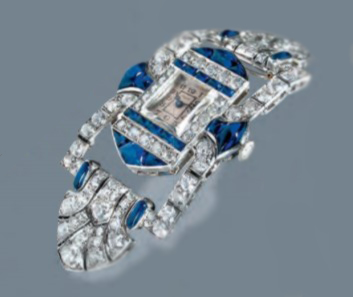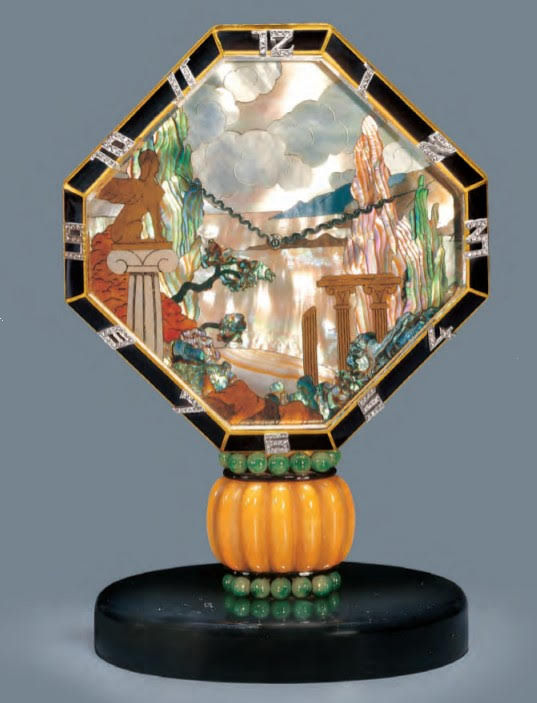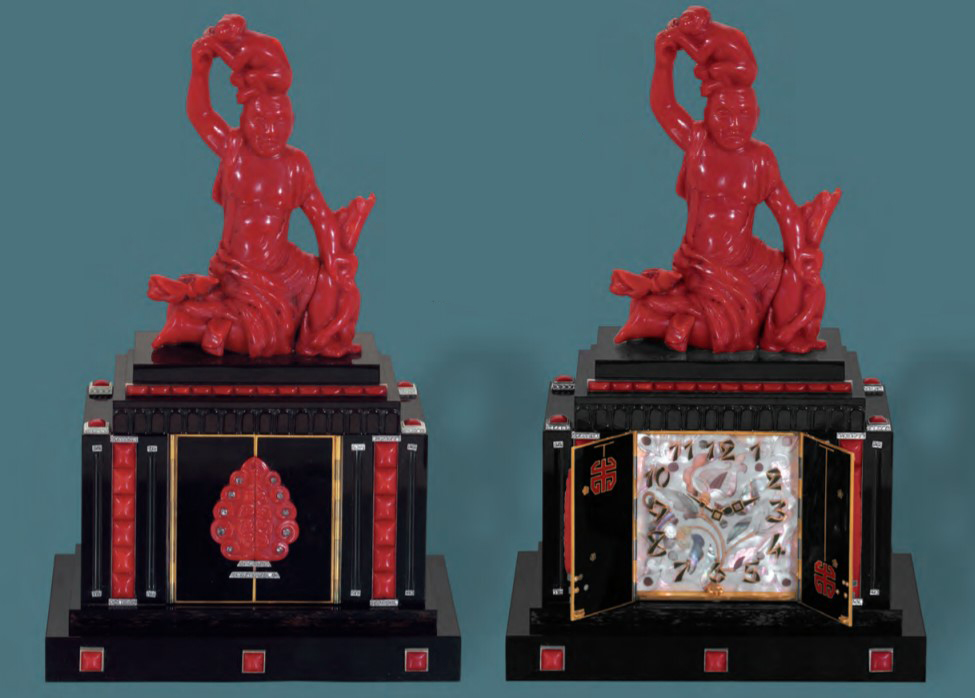Written by Kathryn Bonanno Patrizzi
As many of you may or may not know, my love for jewels of the Art Deco period is as great as my love for fine natural gems. It is a period that is so rich, that one cannot sum up any of its various styles in a single phrase. (Refer to the Art Deco section of The Magical Art of Cartier, Antiquorum’s catalogue of November, 1996, and Antiquorum’s VOX, January, 2003, pages 12-14). There was an enormous amount of travel, which stimulated the imagination and sparked much innovative thought and new discoveries. There was the “chiaroscuro” theme, or “light and dark” – the use of contrast as design, known simply as the black and white style (or any contrasting color with white). There was the “Chinoiserie”, or Chinese influence, as well as the Japanese influence on design. The Persian or Indian style had a huge effect on design, giving us the richly ornate “tutti frutti” with its unabashed use of bright bursts of color. The discovery of Tutankhamun’s tomb gave the Art Deco period a completely new Egyptian Revival style, totally different from that of the 19th century. Of course the clean shapes and geometric themes is that style which most people think of when they think of the Art Deco period, thanks in part to many new gem cuts and the use of platinum, which actually applies to all of the various styles of the period, all of which radiated exotic themes. While I can’t think of a single phrase to describe this magnificent period of jewelry making, two words describe its essence – LUXURIOUS EXOTICISM.

Original Verger rendering 
Ferdinand Verger (1851-1928) 
Original Verger rendering
The French were the true masters of this period. They were the leaders for the rest of the world in this variety of style, and not simply because they are responsible for giving the period its name (named after the “Exposition Internationale des Arts Décoratifs & Industriels Modernes” – the international fair held in Paris in 1925). The “Art Deco” styles developed long before the fair of 1925, and it is interesting to note that this fair had been planned for 1916, but the First World War caused it to be postponed. (There was a large overlap between the Art Nouveau and the Art Deco styles, some jewelers, such as Cartier, shunning the former style). In any event, Paris was the home to many, many fine jewelry firms, both French and foreign, and the cultural exchanges at this time were exciting; many French jewelers traveled abroad for inspiration, and for business, and vice-versa! These, in my opinion, were the most exciting times of all for the jewelry world. Some of the great houses included Cartier, Lacloche Frères, Boucheron, Mauboussin, Marzchak, Marzo, Ostertag, Van Cleef & Arpels, just to name a few. However, there is one major contributor to all of these houses and more, who still remains obscure to many today – a creative force so outstanding that I feel it is an injustice that the name is not automatically synonymous with luxurious exoticism, and that is the house of VERGER!!
The founder of this great firm was Ferdinand Verger (1851-1928), himself a great man from the little I have found out about him. He started his apprenticeship at 11 years old, as was the tradition at the time, went to war, moved to London in 1871, and returned to Paris in 1875. There, he began to work as agent to the famous house of Vacheron & Constantin, of Geneva, from 1879 to 1896 (and later became a partner for the French market). It was in this last year, in 1896, that it is archived that he registered his own trademark – “FV”. In his obituary, in the Journal Suisse d’Horlogerie of 1928, he is called the “apostle of horological art”, and is described as a man of great heart, who was able to organize the Parisian jewelers (he was the President of the “Chambre Syndicale des Bijoutiers”) and even bring together the conflicting egos of the Swiss and French watchmakers. He had known misery in his lifetime, and apparently was a great contributor to various charities, donating jewels to retirement homes and orphanages. In the same obituary, he is described as “the nicest figure in the world of jewelry – and watch makers… armed with an irresistible smile”

Fig. 1: Black + white style, movement by Vacheron & Constantin 
Fig. 2: “Blue Inro” Movement by Vacheron & Constatin, retailed by Lacloche
Ferdinand had two sons, Georges and Henri, who were trained in the great tradition of their father. They joined their father, and in 1911, moved to 51 rue Sainte Anne under the name of Verger Frères, (Verger brothers), -the trademark now be – coming “VF”! It may be interesting to note that Ferdinand, in 1914 sold all of his remaining stock of Lépine, whom he bought out in 1901, to Louis Leroy, the famous Parisian watchmaker, but he kept his trademark. It is in the period of Ferdinand’s sons, especially with George, that the house of Verger Frères reaches its peak, and on January 1st, 1921, Ferdinand officially leaves the business to his sons (according to his letter dated December 31, 1920).

The house of Verger was unique in that it was involved in all the aspects of jewelry making and watch making. The creations of Verger reflect some of the most original designs of the Art Deco period, and while many spectacular jewels are known to have been made, their specialty was the jeweled timepiece. They employed a whole array of artisans – lapidaries, stone-setters, gold-, platinum-, and silversmiths, enamellers, watch-makers and case-makers, designers and renderers and so on, all of whom were fully employed by the firm. In other words, the Maison Verger didn’t subcontract to the various local talents, but made their great works of art, in house!
One of the foremost authorities on the subject of Verger is Ralph Esmerian, whose family was close to the Verger family. As Mr. Esmerian confirms, they went from “the design, to the production, to the final product”, and as he points out, it was not the great retailers that went to Verger Frères with their ideas to be put into production, but Verger Frères that sold their designs to the great houses of the time, giving them each exclusivity for their choices. Verger Frères made for most all of the great maisons around the world. They made for Vacheron & Constantin, Cartier, Lacloche Frères, Marzo, Bousquet, Boucheron, Hermès, Van Cleef & Arpels, Ostertag, Jaeger, Chaumet, Janesich, Fouquet, and others in Paris. They made for American firms such as Charlton & Co., Trabert + Hoeffer, Udall + Ballon, J.E. Caldwell, Black, Starr, & Frost, Spalding & Co., and Tiffany. Other important clients included Bulgari of Rome, Hauser-Zivy y Cia in Mexico, Gübelin of Switzerland, as well as important firms in England, Denmark, and many other important European jewelers.

One cannot define the “style” of Verger; it is as varied and rich and creative as the whole Art Deco period itself. However, the attention to detail – the extra – ordinary workmanship, the use of the finest gems, no matter how insignificant their part may play in the final design, and the originality of the theme is their calling card. I hope that the few examples that are illustrated in this brief article will help the “uninitiated” to appreciate this great house. My personal favorites are the lady’s (of course!) lapel watches, for which Verger Frères were truly masters. These treasures are rare and highly collectable and are always sought after. Not only are they extremely elegant (and easy to wear), but judging from my personal experience, I have yet to find one that is not truly unique and fantastic in design. I have included 4 such jewels in this article, each of a different Art Deco style, and each made in platinum and 18K yellow gold.

The color combination is quite beautiful and quite representative – blue and black enamel, framing red coral flowers with onyx leaves, mounted on a background of round diamonds in platinum – lots of contrasting colors in a linear and floral motif. The entire design is created by the use of gems, creating a picture similar to that of a painting, as opposed to the 3-dimensional, metal flower brooches simply accented with the use of stones, as was the custom in earlier eras. In figure 3, we get even bolder! This is a beautiful example of an Indian “tutti frutti” style lapel watch. This was made for Mauboussin, in 1930, and has just the perfect balance of bright bursts of color seen in the carved leaves and berries, with the round and baguette diamonds. This piece is in perfect harmony – not a bit too much, and yet this tiny jewel stands out boldly, which is the sign of mastery when it comes to this style! It is also unusual in that it has a double clip on the back, rather than a suspended watch section. An interesting and fun jabot lapel watch is illustrated in figure 4 (jabot is like a double-headed stick pin). This piece is totally asymmetrical. It is exquisitely decorated with jade, onyx, natural pearls, diamonds and sapphires. Note that: none of the sections are of the same size; the graduating sapphires are stacked asymmetrically out of the corners; the watch section is hanging off to one side, suspended by sections of natural pearl chain, one side of course shorter than the other – in other words, everything is off symmetry! These are the amusing and whimsical designs of Verger Frères!
Another beautiful watch is figure 5. It is not a lapel watch, but a lady’s wristwatch, which is articulated, allowing for flexibility on the wrist (it would have been worn with a black gros grain strap). This piece was made for Fouquet, and dates circa 1920. It is quite simple in design, but extremely sophisticated with the fine blue, buff-topped sapphires contrasting with the white, round diamonds. As with the Japanese and asymmetrical lapel watches described above, plea se notice how each of the sapphires (or pietre dure) was specifically cut to fit a precise point to complete the design of the piece.

Fig. 6: “Samurai” Movement by Vacheron & Constantin, retailed by Charlton & Co. 
Fig. 7: Movement by Vacheron & Constantin, retailed by Lacloche Freres
On the more masculine side, Verger made many fantastic pocket watches. One such example is figure 6, the “Samurai” dress watch, made for the New York jeweler, Charlton & Co., in the Japanese style. It is very thin, featuring an 18K yellow gold samurai figure on one side, within a background of black enamel and a foreground of green enamel, finely trimmed with white enamel and yellow gold. The dial follows the same style, featuring heavy gold “bamboo” style Roman numerals. It is elegant and exotic at the same time.
There are many such examples of exquisite lady’s wristwatches, but I am only allotted a few pages here, so ….
One of the earlier styles of Art Deco was that of “chiaroscuro”, or the black and white style, which is illustrated in figure 1. The design is still remarkable, often poorly copied today, and it was revolutionary for the time; it was design for design’s sake! (It was not a representation of nature, or man, etc., as in the previous eras) It is extremely simple and elegant, and was made with Vacheron & Constantin. The top portion houses the “pin”, for those unfamiliar with this type of watch, and the watch portion is usually suspended, which allows for easy rotating to view the concealed dial. This lapel watch is made of black onyx, black enamel, round diamonds and a larger marquise-shaped diamond, and natural pearls. Still having a simple and elegant line, figure 2 , exhibits a fine lapel watch made with Vacheron & Constantin, for Lacloche Frères, in the “Japanese” style. It still is designed with the use of contrasting colors, but it is much more elaborate than the black and white style. This piece is called the “Blue Inro”, after the Japanese timepiece that it resembles.
One of the most spectacular ”revivals” of the Art Deco period was the mystery clock, originally invented in the mid 19th century by the magician, Robert Houdin. It is called such because the hands appear to float on the dial, with no apparent connection to the mechanism. Supposedly, only two knew the secret of the mystery in the beginning of the 20th century –the houses of Verger and Cartier. Cartier holds the record for the number of these magnificent clocks sold, and Verger was the sole manufacturer and supplier for Van Cleef & Arpels and several others. Unlike the invention of Houdin, these clocks of Cartier and Verger Frères were incredible works of art – various stones housing the mechanisms, often inlaid or accented with spectacular gems, in gold or platinum, the dials usually of rock crystal, citrine, of some other transparent gemstone. These unique works of art vary considerably – from Cartier’s model “A” with its simple, pure linear geometry, to the very elaborate “Chinoiserie” and Indian styles, but all evoking imagery of the exotic.


More than the mystery clock, however, Verger Frères is probably more widely recognized for their magnificent table, or mantle clocks. Again, the use of exotic themes, exotic gemstones, and unbridled imagination result in magnificent works of art. Figures 7 and 8 offer a taste of this genius. In the first, figure 7, we have an unusual example of the classics. One happily loses oneself in the dial of this clock, pulled in by the details of a world that no longer exists – a Greek sphinx amongst ruins of Doric columns in a strange flora, overlooking a sea with faraway lands in the background. It is absolutely breathtaking in my opinion, and this is all “painted”, or seamlessly inlaid with the use of a little gold and many different types of shell, such as mother-of-pearl and abalone!! Upon further inspection, one sees that this exquisite, octagonal picture is framed in gold and black enamel, with diamond-set platinum Arabic numerals, and that it is in fact, a clock! It is supported by fluted amber that is bordered by jade spheres, atop an oval onyx base. This was made with Vacheron & Constantin, for Lacloche Frères. What a magnificent, functional piece of art, as is also the last example in this article, figure 8 (and on the cover of this magazine). This is another example of the “Chinoiserie” style. It was also made with Vacheron Constantin, for Lacloche Frères, in 1925. Its simple exterior is made of a stepped case in onyx, decorated with sugar-loaf cabochons of coral and accented with diamonds in platinum, flanked by “concave columns” of onyx, intagliato! The top of the case holds a 3- dimensional carving, in coral, of the Chinese Buddha, Hivan Tsang, with two monkeys. The clock is concealed by two black enamel doors that are decorated with a “tree-of-life” or palmette coral carving, accented with diamonds. A coral push-piece releases the spring-loaded doors, revealing a magnificent, highly ornate dial! This dial depicts a lotus flower motif entirely inlaid with mother-of-pearl and abalone shell. Once again, the inlay is seamless! The execution of these clocks must have required a whole team of artisans, but the end result is so magnificent, that they become timeless treasures. There is no doubt regarding the greatness of the house of Verger. If any of you come away from this article with a desire to collect Verger Frères, I will be quite pleased, and I hope you enjoy your new search. It is not always easy to discover a Verger’s identity. Usually, their maker’s mark will be on the inside of the case, as opposed to the retailer’s stamp, which is usually on the surface of the object. The mark to look out for is a lozenge-shaped stamp, with the initials “VF” inside (figure 9); this will be the mark for the most prized Art Deco pieces. The early pieces will bear the early trademark, “FV”, for Ferdinand Verger (after 1872); “VF” for Verger Frères from 1911–1935; Georges Verger et fils from 1935-1945; and Verger et Co. from 1945-1979 (probably run by Georges’ two sons, Claude and Francois). I must say that I am surprised at how many professionals in my business are unaware of this great French firm, and I feel that it is an incredible injustice, as I have already mentioned. This name deserves immortality, as do most of the objects that they made. As Ralph Esmerian concisely put it: “In terms of their creativity and production, they’re [Verger] right at the top of the French manufacturers, including the great retail names”. So the next time you have the pleasure of buying a beautiful Art Deco jewel, especially if it is a timepiece, go a bit further and see if you might be fortunate enough to have a true VERGER FRÈRES!